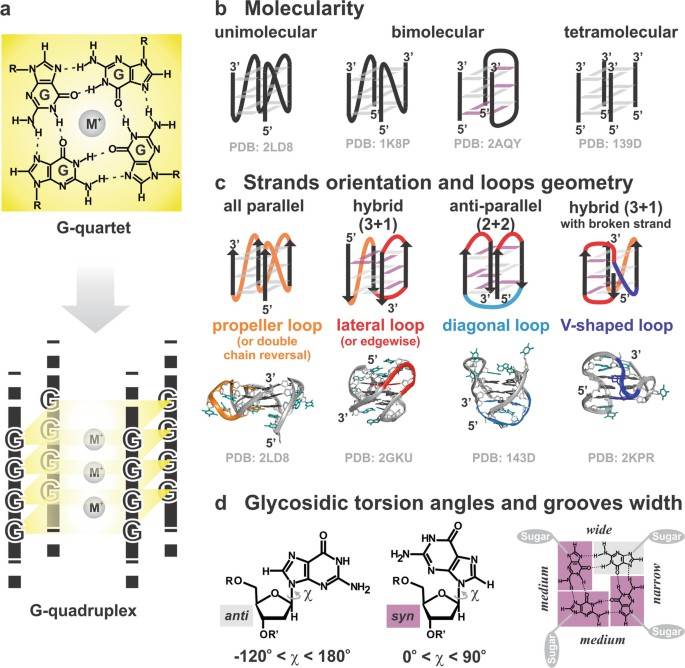Determination of G-Quadruplex Complex Structures
G4 has a variety of structures and unique molecular recognition characteristics, making G4 conjugate a potentially highly specific drug for cancer cells. NMR spectroscopy is an effective method to understand the structure of the G-quadruplex and its interaction with small molecules under physiological conditions.
 Figure 1. G-quadruplex (G4) structure and polymorphism. (Bessi et al., 2018)
Figure 1. G-quadruplex (G4) structure and polymorphism. (Bessi et al., 2018)
As an expert in the field of nuclear magnetic resonance, Creative Biostructure provides NMR-based G4 sample preparation service, structural analysis service, and kinetic analysis service of G4 and compound interaction.
Our Services
NMR sample preparation service
Analysis service of G4 structure
- The equilibrium structure was determined by NMR.
- Determination of G4 folding topology.
- Determination of NMR restricted structure.
Analytical services for G4 interacting compounds
- Analysis of specific G4 drug interactions.
- Monitoring G4 and drug binding analysis.
- Analysis of the effect of drugs on G4.
- Analysis of binding sites or patterns of drugs and G4.
Determination of the G-Quadruplex Formation by 1D 1H-NMR
NMR spectroscopy has unique advantages in studying the secondary structure of DNA G4. As the first step in the NMR structure determination process, it is important to determine G4 formation, sample purity and linewidth through the 1H NMR spectrum in solution. The formation of G4 can be identified by the chemical shift of 1H-NMR imino H1 proton in H2O/D2O solution.
Assignment of Guanine Base Resonances Using Labeled DNA
Only the sequences showing well-resolved NMR spectra can be further studied. NMR structure determination includes NMR resonance distribution and NMR limited structure calculation. NMR resonance allocation of G4 includes proton allocation of guanine base using site-specific 15 N-labeling and complete spectral allocation using the 2D NMR method. After spectrum allocation, first determine the folded topology of G4, and then use the distance limit derived from NMR and MD calculation to determine the three-dimensional structure.
Assignment of Thymine/Cytosine/Adenine Base Resonances
There are several ways we use to allocate base resonances of thymine, cytosine and adenine. COSY, TOCSY, and NOESY spectra can usually be used to allocate these bases. The 1H-13C-HSQC spectrum of the aromatic region can promote the distribution of all base protons, because they gather in a specific region of the 1H-13C-HSQC spectrum according to their type and glycoside twist angle.
Analyse for G4 Interacting Compounds
NMR allows direct analysis of drug interactions with G-quadruplets, such as binding stoichiometry and binding kinetics, and direct monitoring of solution conditions, such as temperature and salt concentration.
To study the drug interaction of a specific G4, we will use DNA sequences that form a single main structure. The sequence should have good NMR spectral characteristics, so it can clearly characterize its drug interaction.
1D 1H NMR titration experiment is used to monitor drug binding interaction. 1D NMR spectra of free drugs and free DNA will be collected and used as a reference.
The chemical shift changes of the DNA-drug complex under various drug equivalents were monitored by 1D 1H-NMR spectroscopy. The imino proton region of the tetrad guanine is well separated from the non-exchangeable proton, so it can be used to monitor the drug-binding interaction and the linewidth change in the titration curve.
In general, the effect of drugs on G-quadruplets can be easily explained by NMR titration. Drugs that bind specific DNA sequences with sufficient affinity will produce NMR spectra with good-resolution peaks. If the drug-DNA complex provides a high-resolution 1H-NMR spectrum, the binding site or mode can be determined.
Creative Biostructure is committed to providing high-quality NMR analysis services to advance the life sciences fields. If you have any questions or needs, please contact us and our customer service staff will help you the first time.
Ordering Process
Reference
- Bessi, I, et al. Targeting G-quadruplex with small molecules: An NMR view. Modern Magnetic Resonance. 2018, 2189-2210.
